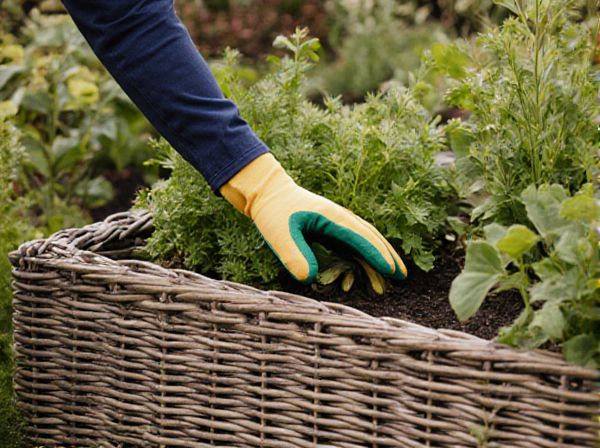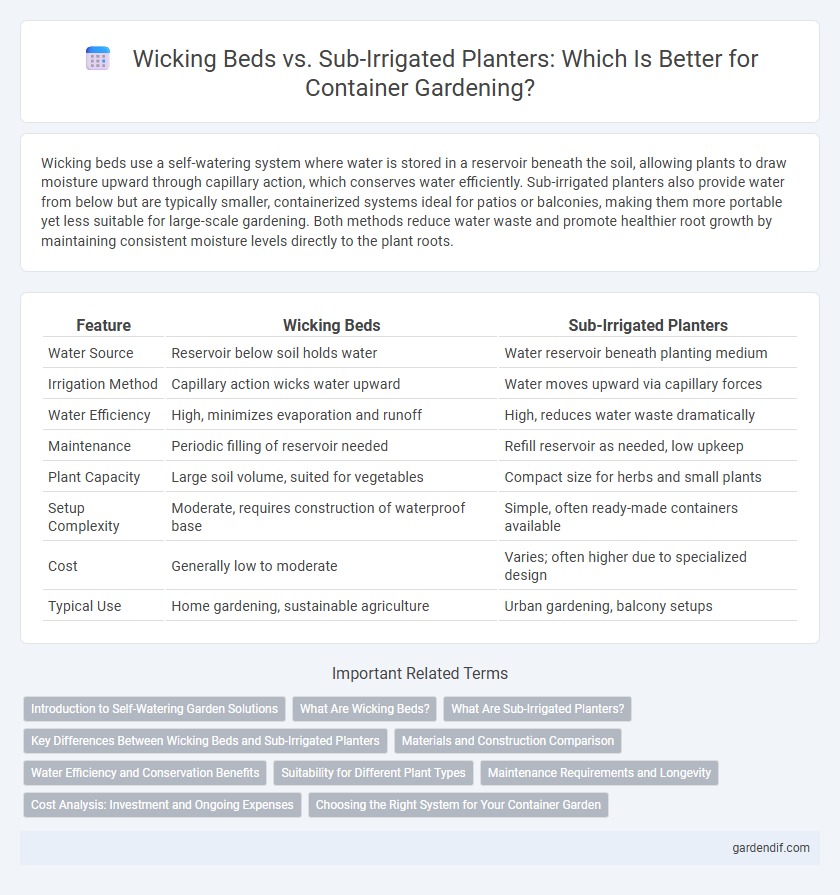
Wicking beds vs sub-irrigated planters Illustration
Wicking beds use a self-watering system where water is stored in a reservoir beneath the soil, allowing plants to draw moisture upward through capillary action, which conserves water efficiently. Sub-irrigated planters also provide water from below but are typically smaller, containerized systems ideal for patios or balconies, making them more portable yet less suitable for large-scale gardening. Both methods reduce water waste and promote healthier root growth by maintaining consistent moisture levels directly to the plant roots.
Table of Comparison
| Feature | Wicking Beds | Sub-Irrigated Planters |
|---|---|---|
| Water Source | Reservoir below soil holds water | Water reservoir beneath planting medium |
| Irrigation Method | Capillary action wicks water upward | Water moves upward via capillary forces |
| Water Efficiency | High, minimizes evaporation and runoff | High, reduces water waste dramatically |
| Maintenance | Periodic filling of reservoir needed | Refill reservoir as needed, low upkeep |
| Plant Capacity | Large soil volume, suited for vegetables | Compact size for herbs and small plants |
| Setup Complexity | Moderate, requires construction of waterproof base | Simple, often ready-made containers available |
| Cost | Generally low to moderate | Varies; often higher due to specialized design |
| Typical Use | Home gardening, sustainable agriculture | Urban gardening, balcony setups |
Introduction to Self-Watering Garden Solutions
Wicking beds and sub-irrigated planters are innovative self-watering garden solutions designed to enhance water efficiency by delivering moisture directly to plant roots through capillary action. This method reduces water waste and ensures consistent hydration, promoting healthier plant growth in container gardens. Both systems empower urban gardeners to maintain optimal soil moisture with minimal maintenance, effectively supporting sustainable gardening practices.
What Are Wicking Beds?
Wicking beds are self-watering containers designed to deliver water directly to plant roots through capillary action from a reservoir beneath the soil, reducing water waste and encouraging deep root growth. Unlike sub-irrigated planters that typically have a simpler water reservoir system, wicking beds feature a permeable layer separated from the soil, ensuring consistent moisture levels and better oxygen availability to roots. Their efficient water use makes wicking beds ideal for drought-prone areas and sustainable gardening practices.
What Are Sub-Irrigated Planters?
Sub-irrigated planters are self-watering containers that use a reservoir system to deliver water directly to plant roots through capillary action, minimizing water waste and ensuring consistent moisture levels. These planters often include a water level indicator and a wicking medium or soil that draws water upwards, promoting healthier root development and reducing the frequency of watering. Ideal for urban gardening, sub-irrigated planters support efficient water management compared to traditional wicking beds by providing controlled irrigation within a closed container environment.
Key Differences Between Wicking Beds and Sub-Irrigated Planters
Wicking beds use a reservoir of water below a soil layer that is wicked upwards through capillary action, providing consistent moisture to plant roots, whereas sub-irrigated planters feature a separate water reservoir with a wicking mechanism directly integrated into the planter's design. Wicking beds are typically larger, garden-scale systems that improve water efficiency and reduce evaporation, while sub-irrigated planters are often smaller, portable containers suited for patios or indoor gardening. The main differences lie in scale, water delivery method, and application environment, affecting plant growth optimization and maintenance requirements.
Materials and Construction Comparison
Wicking beds commonly utilize durable materials such as polyethylene liners combined with soil and mulch layers to create an efficient self-watering system, while sub-irrigated planters often feature molded plastic or resin containers with built-in reservoirs for water storage. Construction of wicking beds involves creating a capillary action zone between the water reservoir and soil, typically using a permeable liner or geotextile fabric to facilitate water movement, whereas sub-irrigated planters are pre-fabricated with integrated wicks and overflow drains for consistent moisture control. Material choice in wicking beds favors customization and larger growing areas, contrasting with the compact, modular design of sub-irrigated planters optimized for small spaces and portability.
Water Efficiency and Conservation Benefits
Wicking beds utilize a self-watering system where water is stored in a reservoir below the soil, allowing plants to draw moisture upward through capillary action, significantly reducing water waste compared to traditional watering methods. Sub-irrigated planters operate on a similar principle, delivering water directly to plant roots, enhancing water retention and minimizing evaporation. Both container types promote water efficiency by maintaining consistent soil moisture levels, reducing the frequency of watering, and conserving water resources effectively.
Suitability for Different Plant Types
Wicking beds are highly suitable for deep-rooted vegetables like tomatoes and carrots due to their consistent moisture delivery system, promoting healthy root development. Sub-irrigated planters excel with shallow-rooted herbs and flowers, providing efficient water uptake without over-saturation. Selecting the right container depends on the specific watering needs and root depth of the plant species being cultivated.
Maintenance Requirements and Longevity
Wicking beds require regular monitoring of water levels and occasional flushing to prevent salt build-up, while sub-irrigated planters need consistent reservoir refilling and occasional root pruning to avoid waterlogging. Both systems reduce watering frequency, but wicking beds typically demand less frequent maintenance due to their soil-based design. Longevity in wicking beds often exceeds that of sub-irrigated planters, as durable materials and simpler construction minimize wear and tear over time.
Cost Analysis: Investment and Ongoing Expenses
Wicking beds typically require a higher initial investment due to the need for materials like liners, reservoirs, and waterproof membranes, while sub-irrigated planters often come as pre-made units that vary widely in price depending on size and features. Ongoing expenses for wicking beds are generally lower since they utilize gravity-fed water systems that reduce water waste and limit the need for frequent refilling, whereas sub-irrigated planters may require additional maintenance or replacement parts over time. Evaluating both options involves balancing upfront costs against long-term savings in water usage and labor to determine the most cost-effective solution for sustainable container gardening.
Choosing the Right System for Your Container Garden
Wicking beds provide a self-watering system that uses capillary action to draw water from a reservoir directly to plant roots, minimizing water waste and encouraging deep root growth. Sub-irrigated planters (SIPs) also feature a water reservoir beneath the soil, but often include a wick or perforated column to distribute moisture evenly, making them ideal for container gardens with limited maintenance. Choosing between wicking beds and SIPs depends on factors like container size, plant type, and watering frequency, with both systems enhancing water efficiency and promoting healthy plant development in confined spaces.
Wicking beds vs sub-irrigated planters Infographic

 gardendif.com
gardendif.com